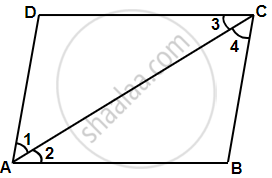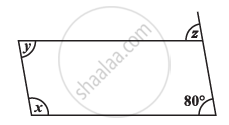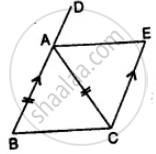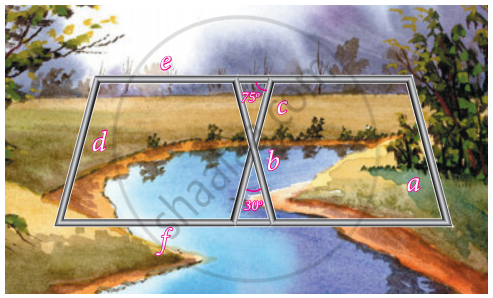Advertisements
Advertisements
प्रश्न
A diagonal of a parallelogram bisects an angle. Will it also bisect the other angle? Give reason.
उत्तर
Let ABCD is a parallelogram.
Given: ∠1 = ∠2
Now, ABCD is a parallelogram.
So, ∠1 = ∠4 [Alternate angles] ...(i)
Also, ∠2 = ∠3 [Alternate angles] ...(ii)
Now, ∠1 = ∠2 ...[Given]
Hence, ∠3 = ∠4 ...[From equation (i) and (ii)]
APPEARS IN
संबंधित प्रश्न
Consider the given parallelograms. Find the values of the unknowns x, y, z.

Perimeter of a parallelogram is 150 cm. One of its sides is greater than the other side by 25 cm. Find the lengths of all sides.
In the given figure, `square`PQRS and `square`ABCR are two parallelograms. If ∠P = 110° then find the measures of all angles of `square`ABCR.

In parallelogram ABCD, E is the mid-point of AD and F is the mid-point of BC. Prove that BFDE is a parallelogram.
Use the information given in the alongside diagram to find the value of x, y, and z.

In the given figure, AB || EC, AB = AC and AE bisects ∠DAC. Prove that:

- ∠EAC = ∠ACB
- ABCE is a parallelogram.
Iron rods a, b, c, d, e, and f are making a design in a bridge as shown in the figure. If a || b, c || d, e || f, find the marked angles between d and f
The adjacent sides of a parallelogram are 5 cm and 9 cm. Its perimeter is ______.
Two angles of a quadrilateral are each of measure 75° and the other two angles are equal. What is the measure of these two angles? Name the possible figures so formed.
ABCD is a parallelogram. Points P and Q are taken on the sides AB and AD respectively and the parallelogram PRQA is formed. If ∠C = 45°, find ∠R.
